Sony XR-55A95L Review
A 55-inch Quantum Dot OLED TV that marks Sony's current flagship TV






Verdict
The 55A95L may not be cheap, but its stellar picture and sound quality make it feel like it’s worth every penny.
Pros
- Stunningly cinematic picture quality
- Attractive but also flexible design
- Warm, detailed and immersive sound
Cons
- Relatively expensive
- No HDR10+ support
- Doesn’t use the latest QD OLED panel
Key Features
- Quantum Dot OLED panelUses self-emissive OLED technology, where a blue organic light source shines through red and green Quantum Dot layers
- Cognivitive XR processorSony’s latest processor adds new upscaling and colour enhancing elements
- Google TV smartsIncludes onboarding of UK specific catch up apps Google TV doesn’t normally support.
- 4K/120 and VRR supportSupports 4K/120Hz gaming feeds, and also supports variable refresh rates to avoid screen tearing
Introduction
While Sony enthusiastically embraces every TV tech going, the one it’s picked for its current flagship model is Quantum Dot OLED.
That seems fair enough given the success it achieved with its debut QD OLED model in 2023, and the rate of knots with which this relatively new take on OLED seems to be improving.
In fact, given how good Sony’s A95K QD OLED debut was, the prospect of what the brand might do with its sophomore effort, represented by the XR-55A95L, is positively mouthwatering.
Availability
As the flagship 55-inch TV in Sony’s current range, the XR-55A95L commands a predictably premium price: £2,499 in the UK, to be precise.
That’s a whopping £1,100 more than Sony’s current traditional (rather than Quantum Dot) 55-inch A80L OLED TV. It’s £800 more than Samsung’s still available 2023 55-inch S95C QD-OLED.
Sometimes, though, if you want the best, you just have to pay for it. So let’s hope for Sony’s sake that the 55A95L is indeed the best.
The XR-55A95L came out in the latter stages of 2023, and current expectations are that it will continue to run until at least the latter stages of 2024.
Design
- Monolithic ‘One Slate’ profile
- Covers for cable runs and connections
- Two desktop height settings
The 55A95L has a suitably flagship look and feel. Its build quality is exemplary with its monolithic, One Slate design feeling robust, heavy duty, and as if it could easily survive an assault by a rogue dog or determined young child.
The way the desktop feet attach under each corner means they end up looking like they’re actually an integrated part of the screen rather than separate items – especially as their gleaming silvery finish matches that of the outer edge of the screen’s bezel.
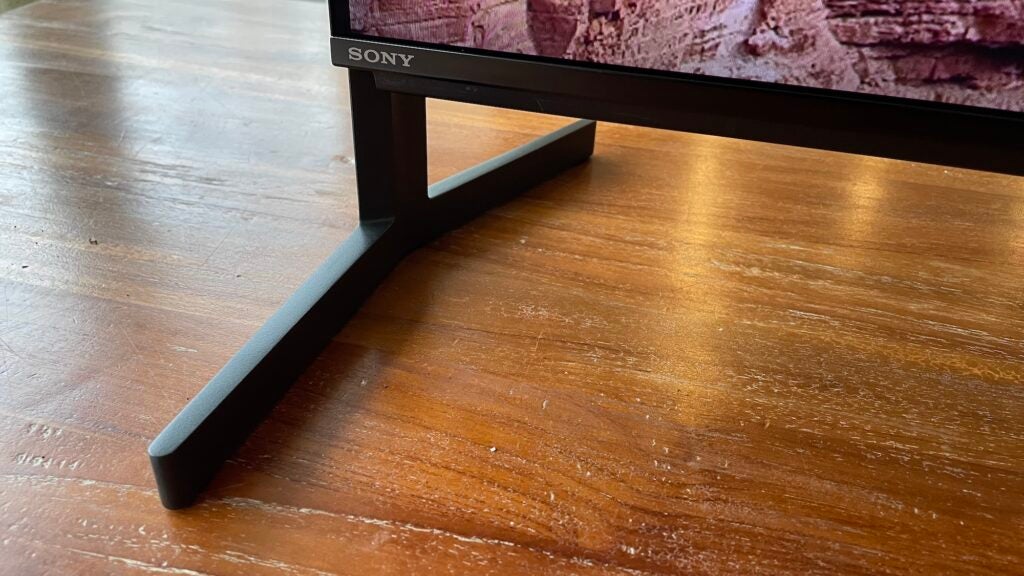
This all-in-one effect works particularly well if you slot the screen right down onto its feet, rather than choosing the alternate attachment option of leaving two or three inches between the screen and the furniture the TV is sat on.
While not as elegant looking, the raised mounting option gives you room to put a soundbar in without obscuring the picture or the TV’s Infra-red receptor.
The bezel around the screen is as ultra-slim as I’ve come to expect from today’s premium TVs, and while it’s rear isn’t as slim as those of one or two OLED rivals, it’s still flat and slender enough to make the XR-55A95L a great wall-hanging option. The rear panel also features removable covers to help you hide all of its connections.
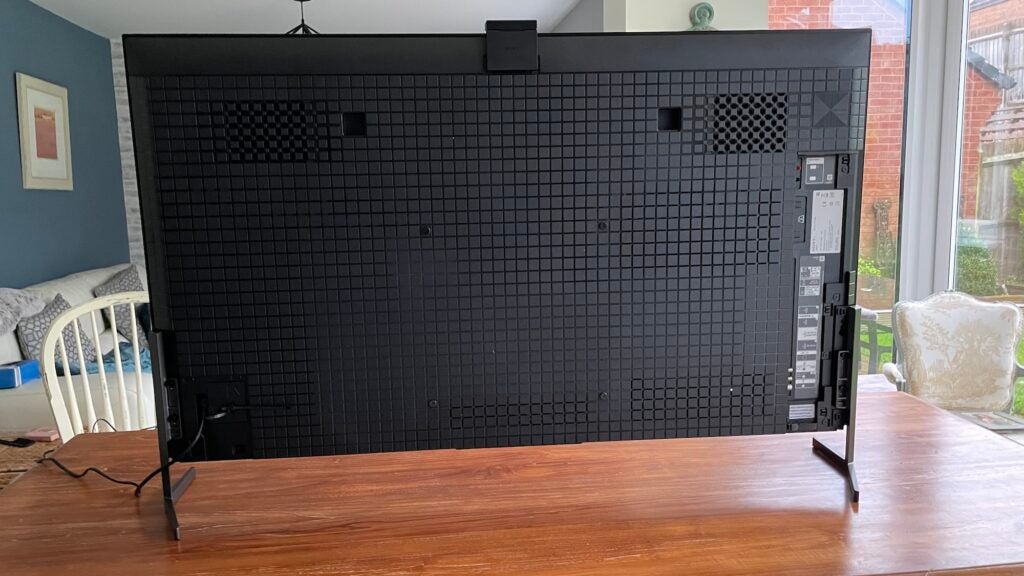
The only potentially annoying thing about the A95L’s design is that its feet can only be attached under the screen’s corners, meaning you’ll need a bit of furniture to sit it on that’s at least as wide as the TV. Only the 77-inch A95L provides the option to move the feet to a more central position.
The A95L ships with two remote controls: a slightly chunky, plasticky old-school affair complete with a full numerical pad and a set of integrated video disc playback buttons, and a sleeker, metallic-looking smart affair that ditches the numerical buttons in favour of a more spacious layout and direct access for the Netflix, Disney+, Prime Video, YouTube, BRAVIA Core, and Crunchyroll services.
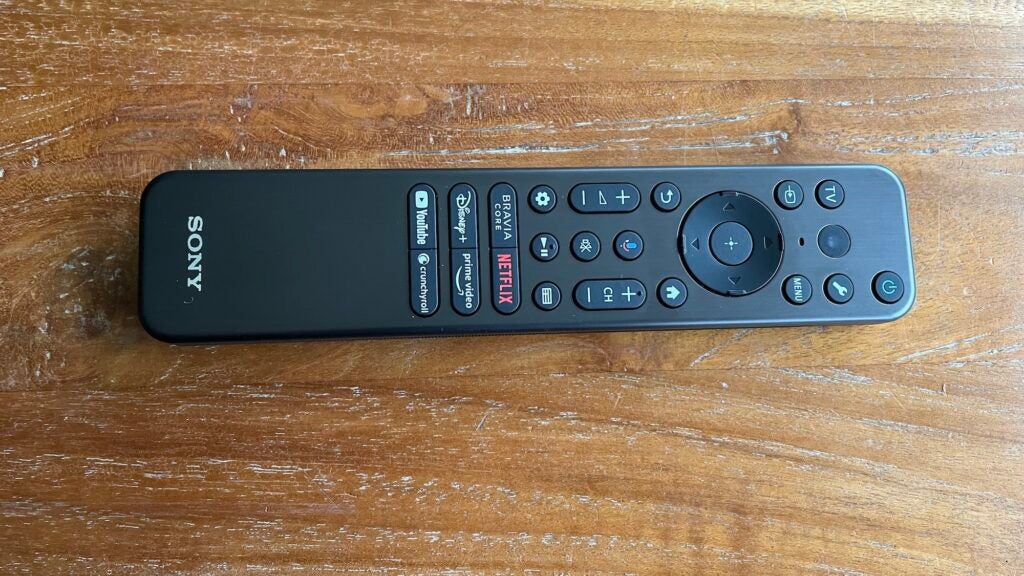
Features
- Cognitive XR processor
- QD OLED panel technology
- Google TV smarts
The headline feature of the 55A95L is its use of a Quantum Dot OLED panel. This loses the brightness-boosting white component of regular OLED TVs in favour of a blue organic light that shines through red and green layers of Quantum Dots. The resulting RGB colour system has the potential to deliver purer colours at high brightness levels.
The new Quantum Dot colour approach is achieved without hindering OLED’s traditional benefit of having every pixel in its screen produce its own light and colour, and without impacting what its neighbouring pixels are doing.
Driving this 4K roster of self-emissive pixels is the latest version of Sony’s Cognitive XR processor. This features a new XR 4K Upscaling system, promising improved upscaling of sub-4K sources (quite a promise given how good Sony’s upscaling has always been), as well as an XR Triluminos Max element that Sony claims can produce and accurately map billions of ‘real-world colours’ – all with that RGB purity QD OLED likes to shout about.
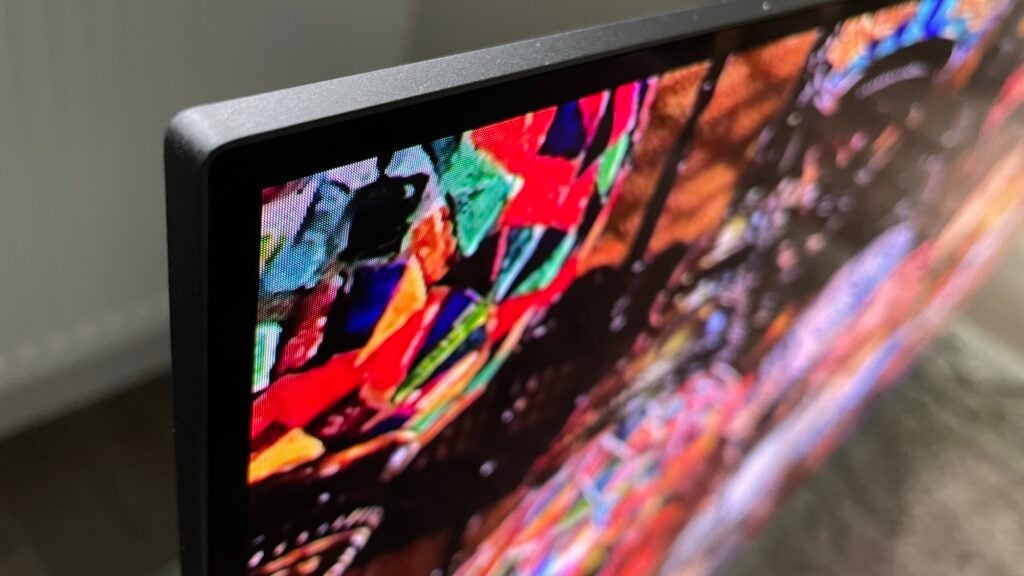
XR OLED Motion adapts Sony’s always dependable motion processing technology to OLED’s specific hardware peccadilloes, cross-analysing key visual elements on successive frames to create a less juddery experience without creating the sort of processed, artefact-laden or overly smoothed look that lesser motion processors are plagued with.
The XR processing elements continue with XR Clear Image, which apparently utilises a combination of ‘zone division and dynamic frame analysis’ to reduce the appearance of noise and motion blur in the picture.
The sort of picture controls afforded by the latest Cognitive XR processor are likely to be more needed than ever for Sony’s second QD OLED generation thanks to this new screen claiming to deliver almost as much as 200% more brightness than its predecessor.
My own measurements find the 55A95L achieving an extremely bright 1337 nits on a 10% white HDR window, which puts it almost up there on the brightness front with its LG G3 and Samsung S95C rivals (though Samsung’s 2024 S95D are able to hit as much as 1800 nits in the same circumstances).
With so much brightness to play with, it’s reassuring to find that the 55A95L carries a heat diffusion sheet to reduce the susceptibility of its organic components to that old OLED enemy of screen burn.
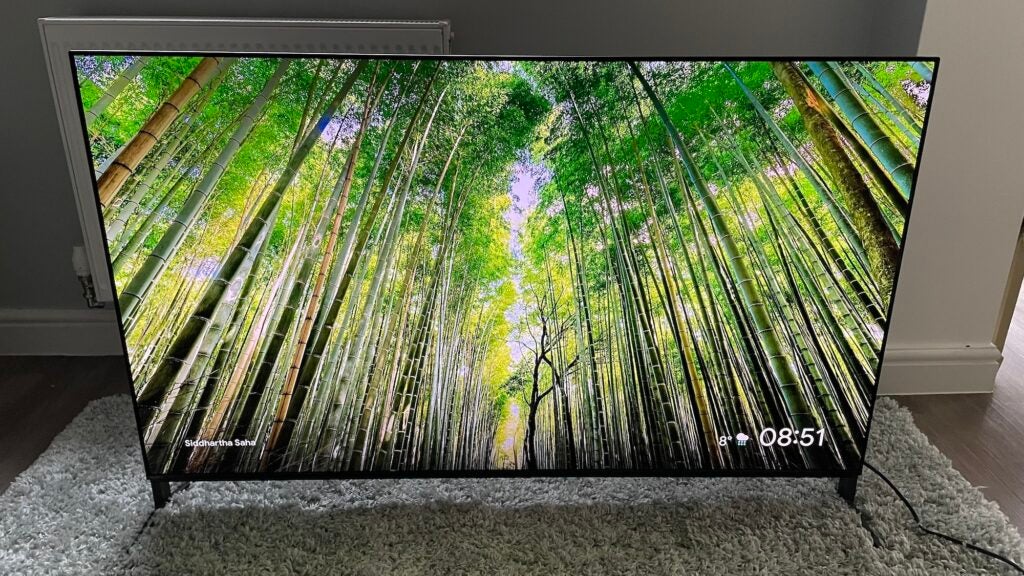
High Dynamic Range support on the A95L covers the Dolby Vision, HDR10 and HLG formats, but not HDR10+. How much this matters to you depends on how much HDR10+ content you have in your library, but aside from Prime Video, I suspect most of you won’t have very much.
Sony’s A95L also sports BRAVIA Core and Netflix Calibrated modes, meaning it can modify its picture settings to get as close as possible to the values used in the streaming services’ own mastering studios.
BRAVIA Core also stands out from the streaming pack by offering its catalogue of films at exceptionally high (up to 80mbps) streaming speeds in a bid to reduce the compression-based picture artefacts you get with regular streaming services. Buying an A95L TV bags you 10 free premium BRAVIA Core movies, as well as a two-year subscription to the service’s back catalogue.
The A95L is also officially certified with the IMAX Enhanced format, used when mastering a fairly small selection of films available on some streaming services and 4K Blu-rays to give them a cleaner, purer look.
Gaming support on the XR-55A95L is a step up for Sony, thanks to its use of a different chipset to other models in Sony’s current range. Still, only two of its four HDMIs support the full range of today’s gaming features, but these two do at least allow you to enjoy variable refresh rates and Dolby Vision HDR gaming simultaneously; you no longer have to switch one off if you want the other.
There’s also support for Sony’s Perfect For PlayStation 5 features, where the TV can always tell whether a connected PS5 is outputting a game or video source, and where a connected PS5 can tell exactly which Sony TV model it’s connected to and optimise its HDR output accordingly.
The 55A95L’s smart features are delivered by Google TV. This means you’re covered for all the main global streaming services, while Sony has made sure to cover Google TV’s blind spot with regards to a couple of the UK’s main terrestrial broadcaster catch up services by bringing them on board as separate apps.
One final unusual smart feature is the BRAVIA Cam. Only available as an optional £199 accessory with models further down Sony’s range, with the 55A95L you get to enjoy its features bundled at no extra cost. As well as obvious video calling uses, the BRAVIA Cam also delivers a couple of unusual extra features, such as the ability to track your position in your room relative to the TV and adjust sound and picture settings accordingly.
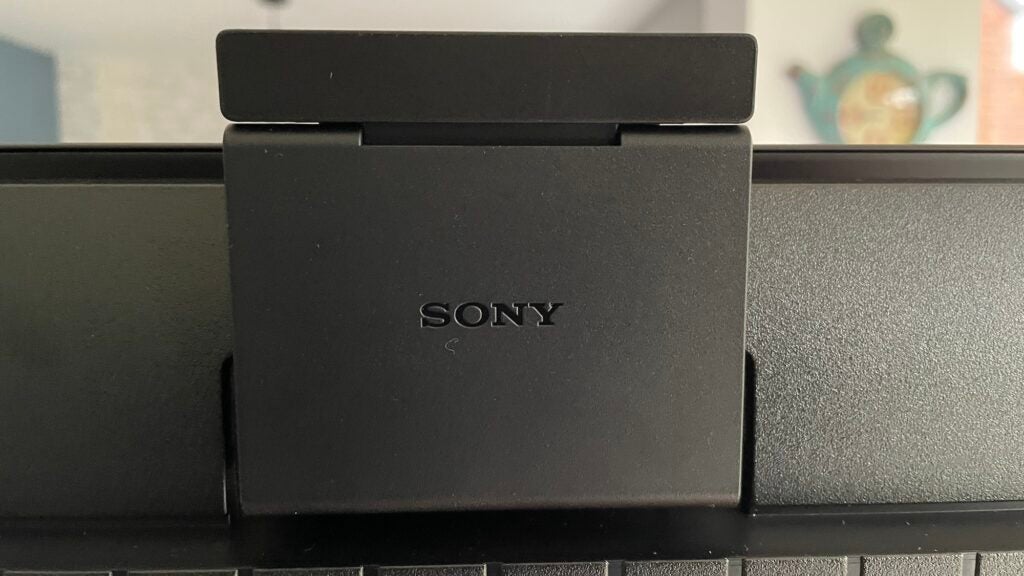
The camera can also monitor your room’s light conditions and adjust the picture settings to compensate, automatically turn the TV on when it senses someone in the room, give an alert if an inquisitive child gets too close to the TV, and even support some basic gesture controls.
Personally, while it’s good to see Sony innovating in this unusual sphere, I didn’t feel really compelled by anything the BRAVIA Cam had to offer.
Picture Quality
- Stunningly rich colours
- Outstanding video processing
- High brightness
The 55A95L takes the natural advantages of QD OLED technology Sony already exploited so well with its debut A95K QD OLED TVs to a whole new level. A level beyond the capabilities of the vast majority – if not all – of its rivals.
The strengths of the 55A95L’s pictures are so wide-ranging that it’s initially hard to start breaking them down into stuff I can describe in this review. Everything just looks beautiful. So beautiful, that it’s tempting to just wrap things up there. Pictures this good deserve to have a bit more thought applied to them, so I’d better give it a go!
As a testament to the quality of Sony’s Cognitive XR processor and its ability to unlock the full potential of the 55A95L’s second-gen QD OLED screen, the first thing that started to jump out about its pictures wasn’t their brightness or colour potency but their subtlety.
Whether it’s the ultra clean, ultra subtle shading detail in dark corners, the fantastically fine shading of colours, the seemingly effortless understanding of the primary and secondary elements in incoming pictures, the beautifully natural handling of motion via Sony’s True Cinema Motionflow setting, or the remarkably natural, effective way the TV adds millions of extra pixels to sub-4K sources in real time, every single pixel always feels like it’s delivering exactly the right brightness, colour and intensity in relation to its neighbours.
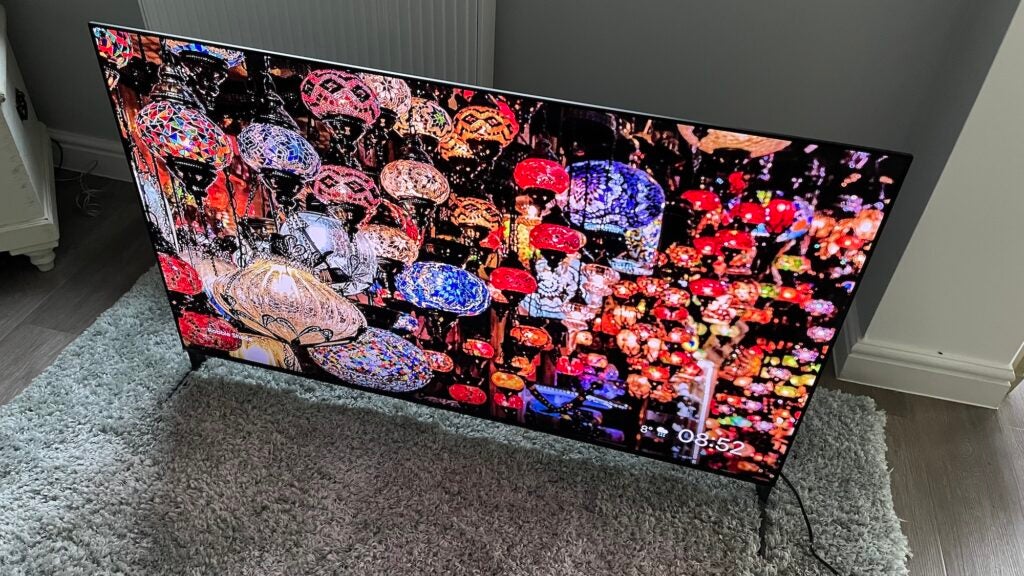
The result of all these various areas of exceptional picture control, finesse and understanding is picture quality so balanced and realistic that it irresistibly draws you into the world of whatever you’re watching. No matter how fantastical that world might be.
The fact that the 55A95L’s ‘small stuff’ makes such a strong impact does not mean it doesn’t also do drama, though. On the contrary, its measurable brightness boost is backed up very clearly by your subjective viewing experience. You can feel the effect of so much brightness in literally every frame.
Peak bright HDR details such as direct shots of the sun, light reflections on glass and metal, streetlights and so on appear with much more contrast-enhancing intensity. Daytime sequences look notably more… daytime. There’s less clipping of subtle picture shading in the brightest highlights. And the 55A95L’s QD OLED-created colours enjoy even more volume and vibrancy than the class-leading efforts of the A95Ks.
In fact, the purest greens, blues, yellows and, especially reds look purer and more accurate than they ever have before.
The precision the 55A95L is able to apply to its huge brightness and colour response helps it create an outstanding sense of sharpness and detail with both native and upscaled 4K imagery too, with some presets also enjoying an almost uncannily three-dimensional, life-like appearance thanks to the TV’s uber-clever analysis of the relative weight of different image elements.
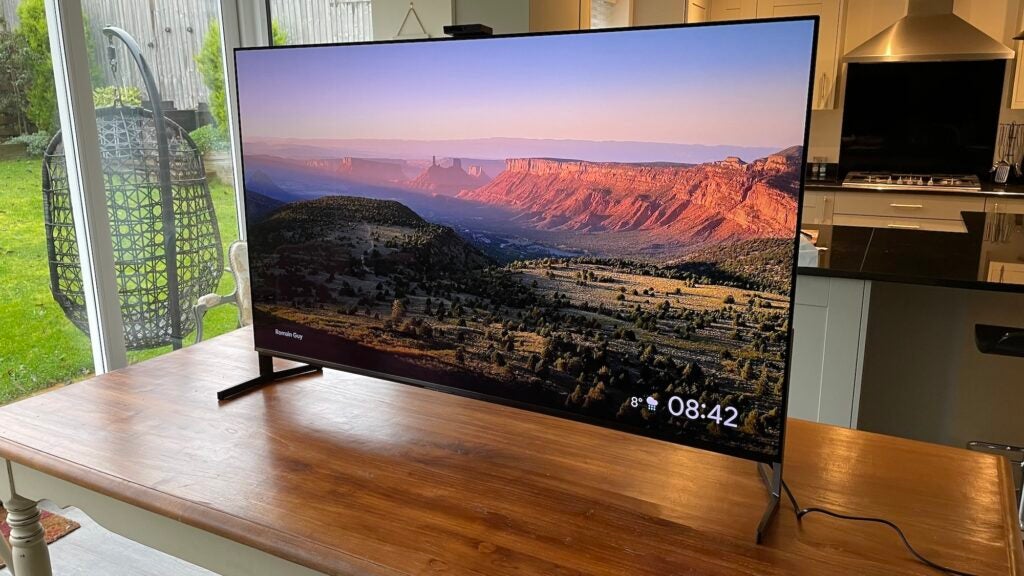
All these Quantum Dot OLED and Cognitive Processor XR benefits are delivered alongside the one picture strength we most associate with OLED technology: impeccably deep, rich, greyness-free black levels. And since these deep black levels can share the screen with ultra-bright highlights without any of the backlight compromises associated with even the most high-end LCD TVs, the 55A95L is able to achieve a truly stunning and consistent sense of local contrast that feels like you’ve stumbled onto HDR’s true heart and soul.
I only have a couple of concerns with the 55A95L’s pictures. First, its Vivid mode is almost bizarrely bad. A garish mess that pushes colours so hard they start to actually break up at times, and no longer look in the least bit natural or balanced. The polar opposite of what Sony’s outstanding TV works so hard to achieve with its other presets. You can avoid these problems by simply not selecting the Vivid preset.
The other issue is that the 55A95L’s brightness has recently being surpassed by a cool 400 nits or so by Samsung’s S95D TVs, which use the latest QD OLED panels. While Sony recently confirmed that it currently has no plans to replace the A95L with newer QD OLEDs, though, the 55A95L’s processing and subtleties ensure it’s still a fantastic TV option for AV fans looking looking for the finer things in AV life.
Sound Quality
- Powerful, well-rounded sound
- Sound pushes forwards into your room
- Exceptionally accurate effects placement
The 55A95L’s attractions certainly aren’t limited to its pictures. It also gets a premium version of Sony’s Acoustic Surface Audio system, where, remarkably, the TV’s actual screen functions as the main speaker system. This immediately delivers the benefit of sound that emanates directly forward, towards your seating position, instantly giving it more impact and immersiveness.
Vibrating the screen rather than relying on regular speaker enclosures crammed into the screen also helps the 55A95L produce an unusually smooth, rounded, warm sound built on a wide, open mid-range that provides plenty of space for details, vocals, ambient sounds and even a decent amount of bass to share the airwaves without any audio element over-powering or butting heads with anything else.
Subwoofers on the 55A95L’s rear add more low frequency response to the already expansive sound from the screen, too, and as one final excellent benefit of the Acoustic Surface system, sound effects are placed with excellent accuracy in exactly the right part of the screen. The sound system can even perfectly track multiple moving noisy objects as they travel around the screen.
My only real complaint about the 55A95L’s sound is that sustained low-frequency rumbles can cause some distortions from the subwoofers. This might give you sufficient reason to pair the 55A95L up with one of Sony’s A series soundbars, but overall adding an external sound system is much less of a necessity with the 55A95L than it is with the vast majority of TVs.
Latest deals
Should you buy it?
You should buy it because its pictures are a home cinema dream come true
The combination of Sony’s Cognitive XR processor and a QD OLED panel are a match made in heaven, delivering an irresistible mix of subtlety and dynamism that brings every movie to gorgeous life.
You shouldn’t buy it because it’s expensive
Despite using an older QD panel than Samsung’s new S95D TVs, it still costs more than the vast majority of 55-inch TVs.
Final Thoughts
While it’s not cheap and doesn’t join Samsung’s recently reviewed QE65S95D in using one of the latest generation of QD OLED panels, Sony’s second-gen Quantum Dot OLED TV remains a wonderfully high-end performer.
It’s capable of combining peerless OLED subtlety with impressive brightness, sharpness and, especially, colour intensity, and also sounds way better than most TVs. For good measure, it even finally gets to grips with Sony’s long-running game limitations.
How we test
We test every television we review thoroughly over an extended period of time. We use industry standard tests to compare features properly. We’ll always tell you what we find. We never, ever, accept money to review a product.
Find out more about how we test in our ethics policy.
Tested across several weeks
Measured with benchmarks
Tested with real world use
FAQs
A relatively new form of OLED technology that shines a blue organic light through red and green Quantum Dots.
Exclusive to Sony OLED TVs, Acoustic Surface technology creates sound by using actuators to excite the TV’s screen.
In principle, QD OLED’s use of an RGB colour system should produce richer colours at high brightness levels than the traditional WRGB OLED technology, which adds a white element to enhance brightness. The Sony 55A95L actually proves this point – though it’s important to say that LG’s OLED TVs have recently done a good job of continuing to expand the colour potential of its WRGB OLED TVs, too.







